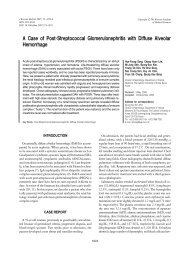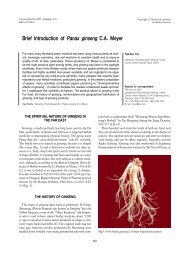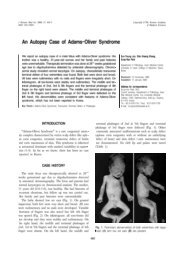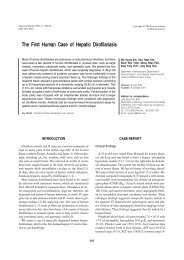Ethnic Coefficients for Glomerular Filtration Rate Estimation by the ...
Ethnic Coefficients for Glomerular Filtration Rate Estimation by the ...
Ethnic Coefficients for Glomerular Filtration Rate Estimation by the ...
- No tags were found...
You also want an ePaper? Increase the reach of your titles
YUMPU automatically turns print PDFs into web optimized ePapers that Google loves.
Lee CS, et al. • Korean <strong>Coefficients</strong> <strong>for</strong> <strong>the</strong> MDRD Study Equations120.0120.06060Equation 9 (mL/min/1.73 m 2 )100.080.060.040.020.00.0r 2 =0.73Equation 10 (mL/min/1.73 m 2 )100.080.060.040.020.00.0r 2 =0.722Eq9-Systemic inulin clearance(mL/min/1.73 m 2 )40200-20-40-60Eq10-Systemic inulin clearance(mL/min/1.73 m 2 )40200-20-40-600.0 20.0 40.0 60.0 80.0 100.0 120.0Systemic inulin clearance(mL/min/1.73 m 2 )0.0 20.0 40.0 60.0 80.0 100.0 120.0Systemic inulin clearance(mL/min/1.73 m 2 )0 50 100 150Systemic inulin clearance+Eq9)/2(mL/min/1.73 m 2 )0 50 100 150Systemic inulin clearance+Eq10)/2(mL/min/1.73 m 2 )120.0120.06060Equation 11 (mL/min/1.73 m 2 )100.080.060.040.020.00.0r 2 =0.754Equation 12 (mL/min/1.73 m 2 )100.080.060.040.020.00.0r 2 =0.757Eq11-Systemic inulin clearance(mL/min/1.73 m 2 )40200-20-40-60Eq12-Systemic inulin clearance(mL/min/1.73 m 2 )40200-20-40-600.0 20.0 40.0 60.0 80.0 100.0 120.0Systemic inulin clearance(mL/min/1.73 m 2 )0.0 20.0 40.0 60.0 80.0 100.0 120.0Systemic inulin clearance(mL/min/1.73 m 2 )0 50 100 150Systemic inulin clearance+Eq13)/2(mL/min/1.73 m 2 )0 50 100 150Systemic inulin clearance+Eq14)/2(mL/min/1.73 m 2 )120.0120.06060Equation 13 (mL/min/1.73 m 2 )100.080.060.040.020.00.0r 2 =0.718Equation 14 (mL/min/1.73 m 2 )100.080.060.040.020.00.0r 2 =0.719Eq13-Systemic inulin clearance(mL/min/1.73 m 2 )40200-20-40-60Eq14-Systemic inulin clearance(mL/min/1.73 m 2 )40200-20-40-600.0 20.0 40.0 60.0 80.0 100.0 120.0Systemic inulin clearance(mL/min/1.73 m 2 )0.0 20.0 40.0 60.0 80.0 100.0 120.0Systemic inulin clearance(mL/min/1.73 m 2 )A0 50 100 150Systemic inulin clearance+Eq15)/2(mL/min/1.73 m 2 )0 50 100 150Systemic inulin clearance+Eq16)/2(mL/min/1.73 m 2 )BFig. 2. Correlation of estimated glomerular filatration rate (eGFR) (equations 9-14) with systemic inulin clearance (reference GFR) (A) and Bland and Altman plots between eGFR(equations 9-14) and systemic inulin clearance (B) (n=147; excluding participants whose reference GFR exceeded 130 mL/min/1.73 m 2 ). (A) Black line: Identical line, gray line:Fit line between systemic inulin clearance and eGFR. Overestimation in advanced renal dysfunction or underestimation in near normal renal function was still observed. (B) Solidred line represents <strong>the</strong> regression line of difference between methods against average of methods. The mean difference is indicated <strong>by</strong> center line, limits of agreement areindicated <strong>by</strong> <strong>the</strong> upper (mean+2SD) and lower (mean−2SD) lines. Eq9-Eq10: The Modification of Diet in Renal Disease (MDRD) study equations using locally measured serumcreatinine (SCr) values <strong>by</strong> a Hitachi 7600 and multiplied <strong>by</strong> <strong>the</strong> Korean ethnic coefficients. Eq11-Eq14: Novel 4 and 6 variable equations using SCr values recalibrated to CX3analyzer (equations 11 and 12) and to Isotope Dilution Mass Spectrometry (IDMS) (equations 13 and 14).method using a Hitachi 7600 (equations 9 and 10) showed betterper<strong>for</strong>mance than did <strong>the</strong> original MDRD study equations(equations 1 and 2), although <strong>the</strong>se improvements were not alwaysstatistically significant. These results guarantee that wecould easily apply <strong>the</strong>se ethnic coefficients and equations <strong>for</strong>usual clinical practice in Korea. The modified MDRD study equationswith ethnic coefficients based on SCr recalibrated to CX3analyzer showed more underestimation. This finding may originatefrom our statistical intention to <strong>for</strong>ce <strong>the</strong> intercept to bezero to permit simple practical application. In fact, <strong>the</strong> interceptsof <strong>the</strong> modified MDRD equation were different from zero (22.37<strong>for</strong> <strong>the</strong> aMDRD and 21.74 <strong>for</strong> <strong>the</strong> 6 variable MDRD). Statisticaldesign <strong>for</strong>cing <strong>the</strong> intercept to be zero also explains <strong>the</strong> discrepanciesbetween <strong>the</strong> Korean coefficient of 0.74 and <strong>the</strong> Japanesecoefficient of 0.881 (8). Because <strong>the</strong> procedure of recalibrationto <strong>the</strong> CX3 analyzer is cumbersome and impractical as well, wesuggest that modification of <strong>the</strong> original abbreviated and 6 variableMDRD equations with 1.09825 and 1.04334 (based on <strong>the</strong>locally measured SCr values <strong>by</strong> <strong>the</strong> Jaffé method) would be moreclinically useful.Although modification of <strong>the</strong> MDRD study equations with <strong>the</strong>measured SCr values (equations 9 and 10) showed sufficientlygood slopes, biases, and accuracies, <strong>the</strong> ethnic coefficients of<strong>the</strong> IDMS MDRD study equations were close to ‘1’ and <strong>the</strong> modifiedIDMS MDRD study equations showed comparable per<strong>for</strong>manceto equations 9 and 10. IDMS, high order referencemethod, have been developed <strong>for</strong> <strong>the</strong> assignment of referencematerials and proficiency testing using a commutable specimenmade each institution derives <strong>the</strong> correlation coefficient <strong>for</strong> individualmeasurement methods versus reference measurement1622 http://jkms.org DOI: 10.3346/jkms.2010.25.11.1616
Lee CS, et al. • Korean <strong>Coefficients</strong> <strong>for</strong> <strong>the</strong> MDRD Study Equationsprocedures (6, 15). Additionally, calibration improved <strong>the</strong> per<strong>for</strong>manceof <strong>the</strong> MDRD study equation, although larger errorsstill remained <strong>for</strong> GFR estimates greater than 60 mL/min/1.73m 2 after calibration (16). Based on our results and those of o<strong>the</strong>rs,we suggest that <strong>the</strong> IDMS MDRD equation will also offer aplausible option hereafter.In contrast to <strong>the</strong> meaningful change in <strong>the</strong> GFR, <strong>the</strong>re is nosignificant change in SCr levels <strong>for</strong> near normal GFR levels. TheNKDEP currently recommends that a GFR estimated above 60mL/min/1.73 m 2 be reported simply as >60 mL/min/1.73 m 2ra<strong>the</strong>r than as a discrete numeric value (5, 6). Variation in <strong>the</strong>calibration of <strong>the</strong> SCr values, biologic and measurement variabilityof GFR at higher levels, and <strong>the</strong> use of an equations developedin a population with CKD provide possible explanations<strong>for</strong> <strong>the</strong> variable results of estimation in a population without<strong>the</strong> disease (5). In this study, percentages of estimated GFRabove 60 mL/min/1.73 m 2 increased after <strong>the</strong> modification ofequations 1 and 2 in CKD stage 2. Fur<strong>the</strong>r, equations modifiedwith ethnic coefficients generally showed better discriminationof estimated GFR less than 60 mL/min/1.73 m 2 in CKD stage 3(data not shown). This means that clinicians could identify patientswho should be managed more carefully and prevent <strong>the</strong>useless consumption of medical resources. Of course, modificationof <strong>the</strong> MDRD study equations based on SCr values recalibratedto CX3 analyzer (Cleveland Clinic Reference Laboratory)(equations 5 and 6) may result in over-treatment of patientsdue to GFR estimation. Because <strong>the</strong> original MDRD study equationsoverestimated <strong>the</strong> real GFR <strong>for</strong> participants with normalto moderate renal dysfunction (slopes <strong>for</strong> 4 and 6 variable MDRDequations: 1.32 and 1.31, respectively), however, underestimationwith <strong>the</strong> modified MDRD study equations might help cliniciansto screen CKD patients more easily. In summary, wesuggest that modification of <strong>the</strong> MDRD study equations wi<strong>the</strong>thnic coefficients (equations 5-10) is very useful and shouldbe adopted into routine clinical practice.Ma et al. (3) reported that using a Chinese coefficient of 1.233<strong>for</strong> <strong>the</strong> original abbreviated MDRD equation improved <strong>the</strong> GFRestimation <strong>for</strong> <strong>the</strong> Chinese population. However, <strong>the</strong> coefficientof 1.233 is much higher than <strong>the</strong> Korean coefficient of 0.74 and<strong>the</strong> Japanese coefficient of 0.881 (based on <strong>the</strong> SCr values recalibratedto CX3 analyzer) (8). Several criticisms to <strong>the</strong> result of<strong>the</strong> Chinese population study exist, including false measurementunit <strong>for</strong> creatinine, use of 99m Tc-DTPA (which differs substantiallyfrom renal clearance), and GFR measurement afterbreakfast. 125 I-iothalamate and radio-labeled DTPA renal clearanceseem to overestimate <strong>the</strong> GFR <strong>by</strong> about 5 mL/min/1.73 m 2compared to inulin clearance, and Agarwal et al. reported thatplasma clearance over 4 hr overestimated <strong>the</strong> GFR <strong>by</strong> 22% to50% (17, 18). All of <strong>the</strong>se matters may explain <strong>the</strong> discrepanciesamong <strong>the</strong> coefficients <strong>for</strong> East Asians.GFR is measured using a variety of methods and filtrationmarkers. Urinary Clin, using a constant infusion, has long beenrecognized as <strong>the</strong> gold standard method (19). However, multiplecomplications (e.g., glucose interference and <strong>the</strong> difficultyin adequate collection of urine) have led to <strong>the</strong> development ofalternative methods (19). Total systemic Clin overestimated urinaryClin, however, it had a much better reproducibility than did<strong>the</strong> urinary Clin. And <strong>the</strong> difference in results generated <strong>by</strong> <strong>the</strong>single injection method and continuous infusion method inchildren was small and was considered acceptable in clinicalpractice (20, 21). Determination of systemic Clin with a singleinjection method is <strong>the</strong>re<strong>for</strong>e a method of general validity <strong>for</strong>measuring <strong>the</strong> GFR without urine collection (21, 22). Theoretically,it is even possible that <strong>the</strong> single injection method mayprovide a more accurate representation of urinary Clin than <strong>the</strong>continuous infusion method (23).In this study, urinary Clin was greater than systemic Clin (Y=1.199×X+1.087, r=0.797). Multiple stepwise errors during timedurine collection and sample dilution occurring due to excessiveinulin concentrations in <strong>the</strong> urine might explain this finding.We suggest that <strong>the</strong> acquisition of systemic Clin would offer abetter approach to measure <strong>the</strong> GFR, and previous several evidenceslead us to believe that <strong>the</strong> Korean ethnic coefficients aremore plausible than Japanese coefficients.When <strong>the</strong> calibration of SCr methods is traceable to <strong>the</strong> SCrreference system, GFR should be estimated using <strong>the</strong> MDRDstudy equation that has been re-expressed <strong>for</strong> standardized SCrvalues (23). Imai et al. reported that <strong>the</strong> Japanese coefficients<strong>for</strong> <strong>the</strong> 4 variable IDMS MDRD study equation was 0.763/0.808(24, 25). These values are markedly different from <strong>the</strong> Koreancoefficient of 0.99. Imai et al. used continuous renal Clin to measureGFR, whereas we used total systemic Clin after single shotinjection of inulin. Differences in <strong>the</strong> reference GFR, creatininecalibration, inclusion and exclusion criteria, and statistical methodused may explain <strong>the</strong> differences in <strong>the</strong> coefficients <strong>for</strong> <strong>the</strong>two ethnicities. More studies to identify and verify <strong>the</strong> IDMSMDRD study equation coefficients <strong>for</strong> Korean and o<strong>the</strong>r populationsin Asia are required. O<strong>the</strong>r variables with <strong>the</strong> potentialto predict GFR (e.g., serum cystatin C) may be included to improve<strong>the</strong> per<strong>for</strong>mance of <strong>the</strong> GFR estimating equations, especiallyin <strong>the</strong> early stages of CKD (26). Recent investigations suggestthat cystatin C may be a better filtration marker than SCr,especially at higher levels of GFR. Novel estimations of GFR usingcystatin C <strong>for</strong> Korean, based on <strong>the</strong> participants of this study,will be reported soon.This study is superior to previous studies because both CKDpatients and healthy volunteers were recruited <strong>for</strong> this study.Thus, ethnic coefficients and novel equations reported here areeasily applicable <strong>for</strong> screening and monitoring CKD (27). However,it is <strong>the</strong> limitation of this study that <strong>the</strong> study populationwas restricted to patients with native kidney disease and withoutserious comorbid conditions that would exclude <strong>the</strong>m fromDOI: 10.3346/jkms.2010.25.11.1616http://jkms.org 1623
Lee CS, et al. • Korean <strong>Coefficients</strong> <strong>for</strong> <strong>the</strong> MDRD Study Equationsmerular filtration rate with standardized serum creatinine values. ClinChem 2007; 53: 766-72.24. Imai E, Horio M, Nitta K, Yamagata K, Iseki K, Tsukamoto Y, Ito S, MakinoH, Hishida A, Matsuo S. Modification of <strong>the</strong> modification of diet inrenal disease (MDRD) study equation <strong>for</strong> Japan. Am J Kidney Dis 2007;50: 927-37.25. Matsuo S, Imai E, Horio M, Yasuda Y, Tomita K, Nitta K, Yamagata K,Tomino Y, Yokoyama H, Hishida A. Collaborators developing <strong>the</strong> Japaneseequation <strong>for</strong> estimated GFR. Revised equations <strong>for</strong> estimated GFRfrom serum creatinine in Japan. Am J Kidney Dis 2009; 53: 982-92.26. Han KH, Han SY, Kang YS, Cha DR. Serum cystatin C concentration comparedwith serum creatinine concentration as a marker of glomerularfiltration rate. Korean J Nephrol 2006; 25: 737-44.27. Rule AD, Teo BW. GFR estimation in Japan and China: what accounts<strong>for</strong> <strong>the</strong> difference? Am J Kidney Dis 2009; 53: 932-5.DOI: 10.3346/jkms.2010.25.11.1616http://jkms.org 1625







